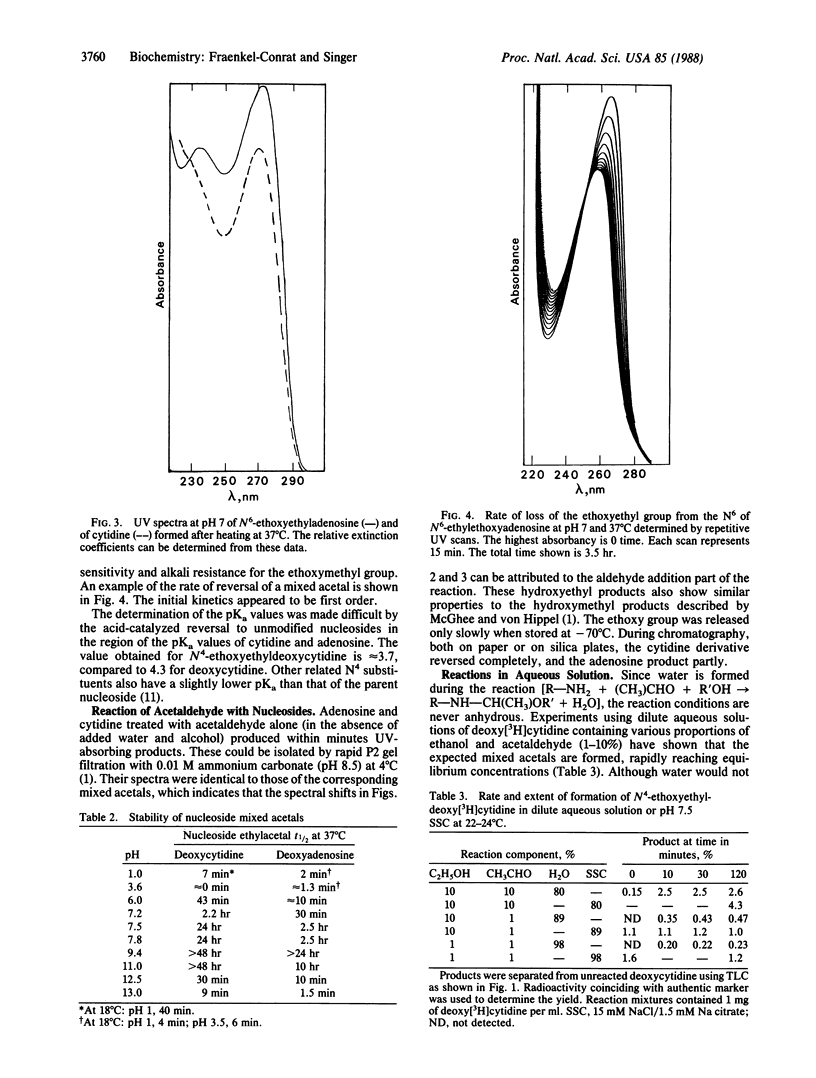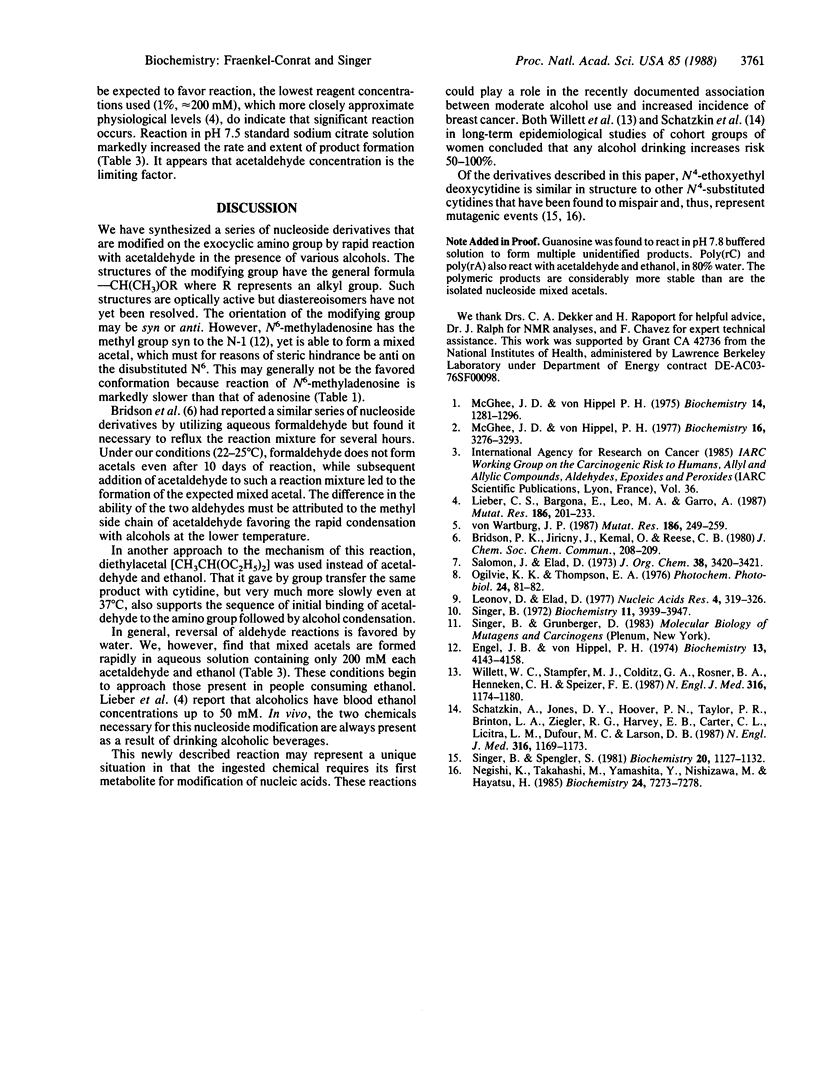Abstract
The exocyclic amino groups of ribonucleosides and deoxyribonucleosides react rapidly at ambient temperature with acetaldehyde and alcohols to yield mixed acetals [--NH--CH(CH3)OR]. Nucleotides and nucleoside di- and triphosphates also react. Depending on the nucleoside used and on the relative amounts of aldehyde, alcohol, and water, preparative reactions reach equilibrium with yields up to 75% in a few hours. The structures have been confirmed by fast atom bombardment MS and proton NMR. Half-lives at 37 degrees C have been determined, and maximum stability is in the pH range of 7.5-9.5. In the absence of alcohol, acetaldehyde-nucleoside adducts could be isolated at 4 degrees C, but these were too unstable to characterize except for their UV spectra, also at 4 degrees C. Ethanol is often present in human blood and tissues, and acetaldehyde is its initial metabolic product, as well as being formed by many other metabolic processes. Both chemicals have separately been implicated in carcinogenic and other cytopathologic processes, but no cooperative mechanism has been proposed. The reactions reported here are of biological concern because they also occur in dilute aqueous solution. These findings supply a mechanism by which ethanol can be covalently bound to nucleic acids under physiological conditions.
Full text
PDF



Selected References
These references are in PubMed. This may not be the complete list of references from this article.
- Engel J. D., von Hippel P. H. Effects of methylation on the stability of nucleic acid conformations: studies at the monomer level. Biochemistry. 1974 Sep 24;13(20):4143–4158. doi: 10.1021/bi00717a013. [DOI] [PubMed] [Google Scholar]
- Leonov D., Elad D. Light-induced free radical alkylation of polynucleotides and their enzymatic digestion. Nucleic Acids Res. 1977 Feb;4(2):319–326. doi: 10.1093/nar/4.2.319. [DOI] [PMC free article] [PubMed] [Google Scholar]
- Lieber C. S., Baraona E., Leo M. A., Garro A. International Commission for Protection against Environmental Mutagens and Carcinogens. ICPEMC Working Paper No. 15/2. Metabolism and metabolic effects of ethanol, including interaction with drugs, carcinogens and nutrition. Mutat Res. 1987 Nov;186(3):201–233. doi: 10.1016/0165-1110(87)90004-2. [DOI] [PubMed] [Google Scholar]
- McGhee J. D., von Hippel P. H. Formaldehyde as a probe of DNA structure. r. Mechanism of the initial reaction of Formaldehyde with DNA. Biochemistry. 1977 Jul 26;16(15):3276–3293. doi: 10.1021/bi00634a002. [DOI] [PubMed] [Google Scholar]
- Negishi K., Takahashi M., Yamashita Y., Nishizawa M., Hayatsu H. Mutagenesis by N4-aminocytidine: induction of AT to GC transition and its molecular mechanism. Biochemistry. 1985 Dec 3;24(25):7273–7278. doi: 10.1021/bi00346a038. [DOI] [PubMed] [Google Scholar]
- Ogilvie K. K., Thompson E. A. Photoreaction of O2,2'-anhydrouridine with ethanol. Photochem Photobiol. 1976 Jul;24(1):81–82. doi: 10.1111/j.1751-1097.1976.tb06801.x. [DOI] [PubMed] [Google Scholar]
- Salomon J., Elad D. Photochemical reactions of nucleic acid constituents. Peroxide-initiated reactions of purines with alcohols. J Org Chem. 1973 Sep 21;38(19):3420–3421. doi: 10.1021/jo00959a044. [DOI] [PubMed] [Google Scholar]
- Schatzkin A., Jones D. Y., Hoover R. N., Taylor P. R., Brinton L. A., Ziegler R. G., Harvey E. B., Carter C. L., Licitra L. M., Dufour M. C. Alcohol consumption and breast cancer in the epidemiologic follow-up study of the first National Health and Nutrition Examination Survey. N Engl J Med. 1987 May 7;316(19):1169–1173. doi: 10.1056/NEJM198705073161901. [DOI] [PubMed] [Google Scholar]
- Singer B. Reaction of guanosine with ethylating agents. Biochemistry. 1972 Oct 10;11(21):3939–3947. doi: 10.1021/bi00771a017. [DOI] [PubMed] [Google Scholar]
- Singer B., Spengler S. Ambiguity and transcriptional errors as a result of modification of exocyclic amino groups of cytidine, guanosine, and adenosine. Biochemistry. 1981 Mar 3;20(5):1127–1132. doi: 10.1021/bi00508a013. [DOI] [PubMed] [Google Scholar]
- Willett W. C., Stampfer M. J., Colditz G. A., Rosner B. A., Hennekens C. H., Speizer F. E. Moderate alcohol consumption and the risk of breast cancer. N Engl J Med. 1987 May 7;316(19):1174–1180. doi: 10.1056/NEJM198705073161902. [DOI] [PubMed] [Google Scholar]
- von Wartburg J. P. International Commission for Protection against Environmental Mutagens and Carcinogens. ICPEMC Working Paper No. 15/5. Acute aldehyde syndrome and chronic aldehydism. Mutat Res. 1987 Nov;186(3):249–259. doi: 10.1016/0165-1110(87)90007-8. [DOI] [PubMed] [Google Scholar]


